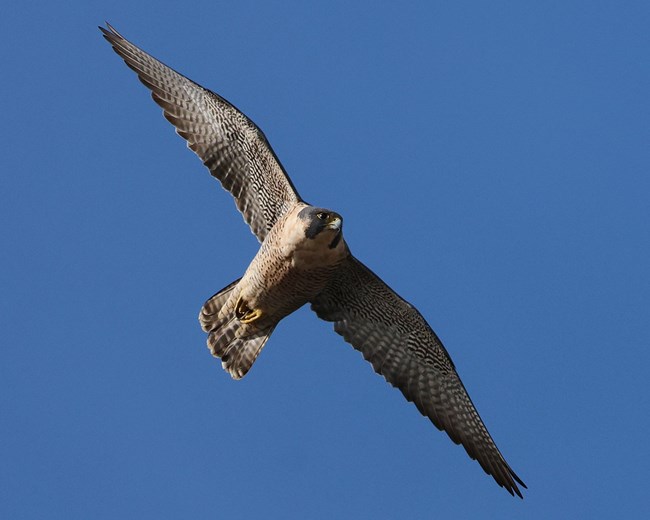Last updated: June 14, 2024
Article
Friends, Enemies, Neither? Making Sense of Baffling Falcon Behavior at Pinnacles National Park

NPS / Gavin Emmons

NPS / Environment for the Americas / Gavin Healy
June 2024 - Over at Pinnacles National Park, two falcon species have stopped visitors and birders alike in their tracks. They are the charismatic and beautiful prairie and peregrine falcons. Falcon numbers at the park have been fairly stable over the years. And while this breeding season is not over, if all current nestlings survive and manage to leave their respective nests, nest success will be a bit below average. But there are a couple of interesting dynamics at play if we look closely. One is winter rain patterns and their possible effect on prairie falcon nest success. Another is the still-mysterious relationship between the two falcon species, both of which rely on the same cliff sites for raising young. This potential for competition has kept biologists on alert, watching the species interact.
Gavin Emmons, a wildlife biologist at Pinnacles, has been monitoring falcons at the park since 2003. He and a team of volunteers spend each spring scouring the park for nesting sites. This year, the team has confirmed eight prairie falcon pairs and four peregrine pairs occupying territories. Currently, there are four active nests with nestlings for both peregrine and prairie falcons. Two prairie falcon nests recently fledged nine young, and the remaining active nests house eight prairie falcon nestlings and three peregrine falcon nestlings. Despite these numbers being below average if the nestlings survive, it may still be a more productive breeding season than last year. But while these highs and lows are normal for falcons at Pinnacles, it is possible that prairie falcon numbers are lower since the return of peregrines 20 years ago. These lower numbers of prairie falcons made me wonder if part of the reason could be chalked up to competition for limited resources.

NPS / Gavin Emmons
The limited resource spurring competition in this instance would be nesting sites for the peregrine and prairie falcons. The two falcons require highly specific cliff sites for nesting, where there is a sheltered space within the cliff face. The height of the cliff provides safety from land predators and an overview of the space beneath where adults can hunt for food with better vantage points. These sites are limited in number. This could possibly explain the documented instances of confrontation between the two birds over nesting sites. Since peregrines returned to nest in Pinnacles, Emmons has seen cases where prairie falcons do not return to cliffs that peregrine falcons start nesting at. But this nesting site competition is not the only dynamic that the monitoring team has noticed.
Since 2014, the monitoring team has had a couple of observations of the falcons nesting nearby each other. From 2020-23 at South Chalone Peak, there were yearly observations of the falcons finding cliff sites near one another and nesting there. They were separated by a visual barrier all four years, and for the 2021 and 2022 seasons both successfully fledged young, although in 2023 the prairie falcon nest failed. They also documented a similar closeness of the falcon species on Balconies, a rock formation on the west side of the park, in 2021 and 2022. At Balconies, the team saw the two falcon species defend nesting territories in the area with little confrontation between the two species themselves. This behavior is fascinating—it seems to blend territorial behavior reflecting a fight for limited resources but also tolerance. What could it all mean?

NPS / Environment for the Americas / Gavin Healy
Really, the team does not know. Of course, I would like a concrete answer on why they are acting this way, but stuff like this takes time. They need time to notice changes in trends and behaviors, and the peregrine falcons have only recently returned to nesting at the park in the last 15-20 years. It requires continued monitoring, for sure, in order to see how the two continue to interact. But what I can say is that it's wonderful to see that between the two species, falcon numbers have been holding steady for quite some time.
For more information
- Pinnacles Raptor Advisories and Raptors webpages
- San Francisco Bay Area Network Falcon Monitoring webpage
- Pacific Coast Science & Learning Center Prairie & Peregrine Falcons webpage
- Contact Wildlife Biologist Gavin Emmons
See more from the Bay Area Nature & Science Blog
